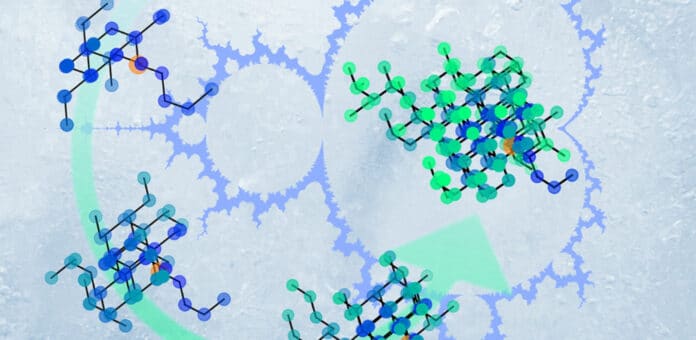Spin ices have crystal lattices that consist of tetrahedra of magnetic ions. In a ground state, two of the four spins on each tetrahedron point in and two point out. When an excitation called the magnetic monopole is created, this rule is violated as the monopole moves through the crystal. Monopole dynamics are reflected in quantities such as magnetic noise, the measurements of which have shown a different frequency dependence from the one that the simplest model predicts.
In a new study, scientists at the University of Cambridge, the Max Planck Institute for the Physics of Complex Systems, the University of Tennessee, and the Universidad Nacional de La Plata identified an emergent dynamical fractal in a disorder-free, stoichiometric, and three-dimensional magnetic crystal in thermodynamic equilibrium. They uncovered this new fractal type in a class of materials called spin ices.
The novelty is due to two factors. First, fractal behavior is typically induced by disorder, whereas the phenomena occur in a clear, flawless three-dimensional crystal. Second, the unusual principles that govern the temporal evolution of the magnetization in these systems give rise to fractals in spin ice. These characteristics led to the term “emergent dynamical fractal” being coined.
The peculiar topological structure of spin ice materials‘ magnetic properties and their capacity to support emerging magnetic monopole excitations have made them stand out in previous years. A fractal pattern appears in most a perfect crystal without disorder for the first time. This is caused by the dynamics of these magnetic monopoles and their interaction with the crystal structure.
In more technical terms, a quantum mechanical process that depends on the magnetic state of adjacent atoms supports the dynamical rules guiding the monopole motion in spin ice. The procedure was implemented in extensive computer simulations, and the outcomes were contrasted with high-resolution experimental observations made at shallow temperatures. The fractals cannot be found through measurements of static attributes because they are dynamic in nature. However, they generate a distinctive measurable signal in the response and variations of the magnetization.
Jonathan N. Hallén, the first author and current Ph.D. student at the Cavendish Laboratory, said, “Indeed, signatures of these fractals had been observed in experiments, some dating back to nearly two decades ago, and they had remained poorly understood to date. Besides the general interest and scientific curiosity of our findings, we thus also explain several puzzling results that have been challenging the scientific community.”
“It will be interesting to see what other properties of these materials may be predicted or explained in light of the new understanding provided by our work. The capacity of spin ice to exhibit such striking phenomena holds the promise of further surprising discoveries in the cooperative dynamics of even simple topological many-body systems.”
Professor Claudio Castelnovo, Theory of Condensed Matter Physics, Cavendish Laboratory, said, “One may wonder whether the slow relaxation observed in these systems – arising from the emergent dynamical fractal behavior – may be used to put forward a possible new paradigm for the appearance of glassiness in systems without the disorder.”
Journal Reference:
- Jonathan Hallen et al. Dynamical fractal and anomalous noise in a clean magnetic crystal. Science. DOI: 10.1126/science.add1644
